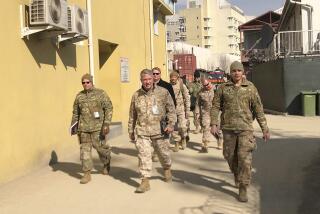U.S. May Have Missed Chance to Oust Hussein
- Share via
WASHINGTON — The Bush Administration may have lost an opportunity to overthrow Iraqi dictator Saddam Hussein in March by ignoring direct Kurdish pleas for support and rebuffing a separate proposal from the Saudis that the two nations join together to bolster the Kurdish and Shiite insurrections, according to a congressional report released Thursday.
The rejections came at a time when dissidents within Hussein’s own armed forces apparently were willing to help the rebels and were waiting only for a favorable signal from the United States, the report by the staff of the Senate Foreign Relations Committee says.
Because of the Americans’ silence, the report says, the military officials remained loyal and the rebellion was crushed with appalling brutality.
The White House, however, denied the allegations, saying that the Administration at no time discouraged Iraqi officials from taking sides against the Baghdad regime. “I guarantee you anybody who wanted to come over or change sides is welcome to do so. And we would not have sent any signals to the contrary,” White House Press Secretary Marlin Fitzwater said.
The committee report “is a replay of an old story,” added another Administration official. “It’s a mish-mash.”
The study, written by senior committee staff member Peter W. Galbraith and based on extensive research in the region as the uprisings were in progress, is the most comprehensive critique of Administration postwar policy since the revolts began. Its findings may provide fodder for Democrats and others seeking to forge a new U.S. foreign policy in the region.
The report also asserts that the United States will be compelled to keep military forces in Iraq for an indefinite period because Kurdish refugees who fled the area will never be willing to return home without a firm security guarantee.
“The Kurds are at risk of slaughter as long as Saddam Hussein remains in power, and so the foreign protection will need to continue indefinitely,” the report says. “Unless the United States is prepared to abandon the Iraqi people, it will be involved in the Iraqi quagmire for a long time to come.”
The lost opportunity for the United States to help Kurdish and Shiite Muslim rebel forces overthrow Hussein “is directly traceable to a policy of no contact with the Iraqi opposition” that predates the Gulf conflict, the report says.
The policy dates back to a 1988 State Department directive issued after a controversy over low-level U.S. contacts with Kurdish rebel leader Jalal Talabani, head of the Patriotic Union of Kurdistan. Iraq and Turkey both protested the Talabani contacts. Despite the unfolding Gulf crisis, the policy was never changed.
On the first day of Operation Desert Storm in January, Iraqi opposition officials approached the Bush Administration with “offers of military cooperation and of military intelligence,” the report says. “They were . . . spurned.”
On the day the allied coalition halted its successful military offensive in February, Kurdish leaders were again in Washington. Despite repeated requests for talks, they were snubbed once more, it says.
In addition, the Administration did not respond to a Saudi proposal that Washington and Saudi Arabia “together militarily assist both (Shiite) and Kurdish rebels” as they attempted to overthrow Hussein’s government after the war, according to the report.
Although the postwar uprisings gained momentum and temporarily seized control of parts of both northern and southern Iraq, the Administration continued to ignore the Saudi offer to help the rebels, the committee report maintains.
“The public snub of Kurdish and other Iraqi opposition leaders was read as a clear indication (that) the United States did not want the popular rebellion to succeed,” the report states. “Given the negative signals from Washington, the potential military defectors sat on the fence. And while they did so, the anti-Saddam rebellion was crushed.”
The failure to signal support to the rebels also encouraged Baghdad to engage in “wholesale massacres” of civilians and instant executions of captured rebels, resulting in tens of thousands of deaths in the Kurdish and Shiite regions of the country, the report says.
Galbraith, a Persian Gulf specialist, traveled more than 150 miles in the northern Kurdistan region during the rebellion and narrowly escaped across the Tigris River to Syria as the uprising collapsed.
Galbraith was an eyewitness to many atrocities committed by the Iraqi army, including use of phosphorous weapons and heavy shelling of civilian areas. “Phosphorous shells, which can instantly cremate their victims, were used extensively and with maximum terror impact,” he wrote.
In the Shiite-dominated south, “captured rebels typically were lined up, nooses strung from the lowered barrel of a tank gun were placed around their necks, and then the rebels were hanged as the gun barrel was raised. (Shiite) holy shrines in Najaf and Karbala became (sites) for the slaughter of rebels, clerics and alleged sympathizers,” the report says.
The report charges that “the plight of Iraq’s (Shiites), while far less visible than that of the Kurds, is certainly more severe than currently depicted.”
Although an international relief operation is in progress to help more than 2 million Kurds who sought refuge in Turkey and Iran, the report declares that another 1 million Kurds may be victims of the unsuccessful uprising.
They are residents of the “victory cities” created by Baghdad when it eliminated all northern Kurdish villages in the late 1980s.
Although the camps were briefly controlled by rebels during the uprising, many residents could not flee when the rebellion collapsed because they lacked food and transportation.
The report seriously questions whether the havens created in northern Iraq by U.S. and European forces will work. Without further security guarantees, the Kurds “are not likely to stay,” it predicts. “Others will not come at all.”
More to Read
Get the L.A. Times Politics newsletter
Deeply reported insights into legislation, politics and policy from Sacramento, Washington and beyond. In your inbox three times per week.
You may occasionally receive promotional content from the Los Angeles Times.










